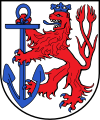Düsseldorf
![]()
The title of this article is ambiguous. For other meanings, see Düsseldorf (disambiguation).
![]() is the capital of North Rhine-Westphalia and the administrative seat of the Düsseldorf administrative district. The independent city on the Rhine is the second largest city in the state, with 620,523 inhabitants as of December 31, 2020. In Germany, Düsseldorf is the seventh largest city by population. Düsseldorf is part of the Rhine-Ruhr metropolitan region with a population of around ten million and the Rhineland metropolitan region with a population of 8.6 million. The city lies at the core of the central European economic area.
is the capital of North Rhine-Westphalia and the administrative seat of the Düsseldorf administrative district. The independent city on the Rhine is the second largest city in the state, with 620,523 inhabitants as of December 31, 2020. In Germany, Düsseldorf is the seventh largest city by population. Düsseldorf is part of the Rhine-Ruhr metropolitan region with a population of around ten million and the Rhineland metropolitan region with a population of 8.6 million. The city lies at the core of the central European economic area.
In 1288, the town at the confluence of the Düssel River and the Rhine was granted the status of a town. From the end of the 14th century to the beginning of the 19th century, the city was the seat of government of lands of the Holy Roman Empire and the Confederation of the Rhine: the Duchy of Berg, the Duchies of Jülich-Berg and Jülich-Kleve-Berg and the Grand Duchy of Berg, from 1690 to 1716 also the residence of Count Palatine and Elector Johann Wilhelm von der Pfalz. Prussian since 1815, it became the seat of the Düsseldorf administrative district in 1816. From 1824 to 1932, the city was the parliamentary seat of the Rhine Province. During the Empire, Düsseldorf developed into the "desk of the Ruhr region" in the course of Germany's high industrialization and became a major city when it passed the 100,000 population mark in 1882.
The metropolis on the Rhine is one of Germany's five most important economic centers with strong international ties. Düsseldorf is a trade fair city and home to many listed companies, including the DAX-listed Henkel Group. It is also Germany's top-selling location for auditing, management consulting and clothing fashion, as well as an important financial and stock exchange center. It is also among the leading locations in Germany for art trading.
Düsseldorf has several ports on the Rhine. Its airport is the intercontinental hub of North Rhine-Westphalia. The city is also home to 22 universities, including the renowned Düsseldorf Art Academy and Heinrich Heine University. Düsseldorf also enjoys supraregional fame for its Old Town ("longest bar in the world"), its shopping boulevard Königsallee ("Kö"), its Düsseldorf Carnival, the Fortuna Düsseldorf soccer club and the Düsseldorf EC ice hockey club. Other attractions include numerous museums and galleries, as well as the Rhine River promenade and the modern Media Harbor. The cityscape is also characterized by numerous skyscrapers and church towers, the 240-meter-high Rhine Tower, many architectural monuments and seven Rhine bridges. Notable is the large number of East Asian residents, including the Japanese community, which forms the largest Japanese community and the only Japantown in Germany.
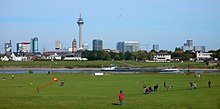
Dusseldorf panoramic view from the opposite side of the river Rhine

Düsseldorf on the Rhine with old town and harbor

Official logo of the state capital Düsseldorf

Dusseldorf, city panorama

Düsseldorf, view to the west
Geography
Spatial position
Düsseldorf, which is predominantly located on the right bank of the Rhine, is situated in the central part of the Lower Rhine lowlands on a low-terrace area crisscrossed by numerous arms of the Rhine. Only the districts of Oberkassel, Niederkassel, Heerdt and Lörick are located on the left bank of the Rhine.
The city is part of the prosperous Rhine region and borders the Ruhr area to the southwest. It is thus located in the heart of the Rhine-Ruhr metropolitan region as well as in the transitional area between the Lower Rhine and the Bergisches Land, to which the city, historically speaking, belongs. The Rhine-Ruhr metropolitan region is an economic region and an urban agglomeration in western Germany. It is one of the largest conurbations within the European megalopolis and is the largest in Germany. Around eleven million inhabitants live in the region's 20 independent cities and ten districts on an area of just under 10,000 km² (as of 2005); around nine million people live within a radius of 50 kilometers of the regional center Düsseldorf alone.
Its central location in Germany's largest conurbation, its function as the capital of the densely populated state of North Rhine-Westphalia, the large number of important companies and its infrastructure and facilities of all kinds give the city great advantages in terms of feel and agglomeration.
The highest point in the city area, the Sandberg in the district of Hubbelrath, already part of the Mettmann Loess Terraces and thus of the Bergisch-Sauerland lowlands, measures 165 m, the lowest point, the mouth of the Schwarzbach into the Rhine near Wittlaer, 28 m above sea level.
The geographical center of Düsseldorf is located in the Düsseltal, the point is marked with a bronze plaque.
Düsseldorf is located in the center of the zone of Central European Time.
Climate
The climate of the Düsseldorf area is oceanic/atlantic due to the relief-related opening towards the North Sea. Düsseldorf lies in the Lower Rhine lowlands; predominantly westerly wind currents carry moist air masses in. The consequences are mild winters with little snow and moderately warm, humid summers with changeable weather. Thus, with an annual mean temperature of 11.2 °C, the city has an average of around 790 mm of precipitation. The Düsseldorf area is one of the areas with the mildest winters in Germany. Even in winter, the temperature rarely falls below freezing. Oncoming frosts usually remain in the upper range just below 0° C. According to the USDA classification ofwinter hardiness zones, Düsseldorf is located in zone 8b, and even in zone 9a for inner-city microclimates, which means that the average coldest annual temperature is above -6.6 °C. With around 1550 hours of sunshine, Düsseldorf is one of the less sunny cities in Germany, which also makes for milder temperatures in winter due to overcast skies and thus less temperature radiation. Because of the mild climate, many exotic and Mediterranean plants such as palms, olives, laurel, figs, pines and cypresses are cultivated outdoors in the Düsseldorf area.
| Düsseldorf | ||||||||||||||||||||||||||||||||||||||||||||||||
| Climate diagram | ||||||||||||||||||||||||||||||||||||||||||||||||
| ||||||||||||||||||||||||||||||||||||||||||||||||
| Monthly average temperatures and precipitation for Düsseldorf
Source: DWD, data: 2015-2020 | |||||||||||||||||||||||||||||||||||||||||||||||||||||||||||||||||||||||||||||||||||||||||||||||||||||||||||||||||||||||||||||||||||||||||||||||||||||||||||||||||||||||||||||||||||||||||||||||||||||||||||||||||||||||||||||||||||||||||||||||||||||||||||||||||||||||||||
Air quality and environmental protection
Energy production, industry and traffic are the main causes of anthropogenic, i.e. man-made, air pollution. Due to the high air pollution, the district government of Düsseldorf draws up air pollution control plans. The first air pollution control plan for the entire urban area of the state capital Düsseldorf came into force on November 1, 2008. It combined all the plans drawn up up to that point into one overall plan. Once the plan has come into force, the measures are implemented by the relevant authorities. The aim of this air pollution strategy is to achieve compliance with the statutory limits as quickly as possible in order to protect the health of the population living and working in Düsseldorf.
Within the framework of air pollution control planning to date, considerable success has been achieved for almost all air pollutants, in particular for particulate matter, which was still critical at the beginning of the 2000s, and the limit values have been complied with. However, the limit value of 40 micrograms per cubic meter of air (annual average) for nitrogen dioxide (NO2), which has been in force since 2010, is still clearly exceeded in Düsseldorf. At the Corneliusstraße measuring point, the annual mean value in 2017 of 56 μg/m³ was still at a very high level of NO2 pollution. For some time now, in addition to the particulate matter fractions, the so-called ultrafine dusts have also increasingly been the focus of attention, especially in the vicinity of airports.
The Düsseldorf NO2 pollution area ("environmental zone") covers a large part of the city area with about 420,000 inhabitants, corresponding to 68% of the population. In this respect, there is a need for action to further reduce NO2 pollution in the planning area.
City area
The urban area of Düsseldorf consists of ten boroughs, which are divided into 50 districts.
The city districts with their associated neighborhoods
In contrast to other major cities in North Rhine-Westphalia, the city districts in Düsseldorf do not have their own names, but are numbered from 1 to 10. City district 3 has the most inhabitants with around 109,000 inhabitants, and Bilk (around 37,000 people live there) is also the most populous district in city district 3. City district 10, on the other hand, has the smallest population with around 25,000 inhabitants, and among the city districts, Hafen has the smallest population with 123 inhabitants.
The city districts and neighborhoods are in detail:
- City district 1: Altstadt, Carlstadt, Derendorf, Golzheim, Pempelfort, Stadtmitte
- City district 2: Düsseltal, Flingern-North, Flingern-South
- City district 3: Bilk, Flehe, Friedrichstadt, Hafen, Hamm, Oberbilk, Unterbilk, Volmerswerth
- City district 4: Heerdt, Lörick, Niederkassel, Oberkassel
- City district 5: Angermund, Kaiserswerth, Kalkum, Lohausen, Stockum, Wittlaer
- City district 6: Lichtenbroich, Mörsenbroich, Rath, Unterrath
- City district 7: Gerresheim, Grafenberg, Hubbelrath, Knittkuhl, Ludenberg
- City district 8: Eller, Lierenfeld, Unterbach, Vennhausen
- City district 9: Benrath, Hassels, Himmelgeist, Holthausen, Itter, Reisholz, Urdenbach, Wersten
- City district 10: Garath, Hellerhof
For more information on the topic, see the list of Düsseldorf's city districts and the list of Düsseldorf's city neighborhoods.
Neighboring cities
The city of Düsseldorf is bordered to the north by the independent city of Duisburg and the city of Ratingen, to the east by the cities of Mettmann, Erkrath and Hilden, to the south by the cities of Langenfeld (Rhineland) and Monheim am Rhein (all in the Mettmann district) and to the west by the cities of Dormagen, Neuss and Meerbusch (all in the Rhine district of Neuss).
| Meerbusch | Duisburg | Ratingen |
| Neuss |
| Mettmann, Erkrath |
| Dormagen | Langenfeld, Monheim on the Rhine | Hilden |
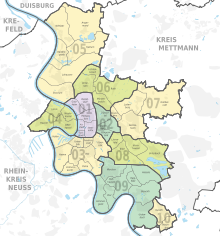
Map of the districts and neighborhoods of Düsseldorf
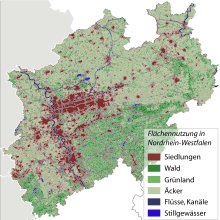
Settlement structure of North Rhine-Westphalia, centrally located the Rhine-Ruhr conurbation with Düsseldorf in the center
Population
→ Main article: Population development of Düsseldorf
| Migrant groups with the largest populations in Düsseldorf by country of origin/country of origin on December 31, 2017 | ||
| Rank | State | Population |
| 1. | Turkey | 12.707 |
| 2. | Greece | 10.388 |
| 3. | Poland | 9.316 |
| 4. | Italy | 7.799 |
| 5. | Japan Japan | 5.829 |
| 6. | Syria | 5.820 |
| 7. | Romania | 4.856 |
| 8. | Spain | 4.477 |
| 9. | Morocco | 4.541 |
| 10. | Russia | 4.430 |
| 11. | North Macedonia | 3.842 |
| 12. | Croatia | 3.720 |
| 13. | France | 3.328 |
| 14. | Ukraine | 3.266 |
| 15. | Serbia | 3.088 |
| 16. | Iraq | 3.079 |
| 17. | Iran | 2.962 |
| 18. | India | 2.848 |
| 19. | Netherlands | 2.542 |
| 20. | United Kingdom | 2.469 |
On December 31, 2012, the "official population" for Düsseldorf was 593,682 after updating based on the 2011 census. Of these, 308,014 were women (51.88%) and 285,668 men (48.11%). The percentage of foreigners was 16.55%, i.e. 98,235 inhabitants. According to the city's census, Turks represented the largest group of non-Germans in 2006 with 15,191 people, followed by Greeks with 10,591 and Italians with 6890. Of the non-European countries of origin, Asians (excluding Turks) make up the largest group with 14,639, including Japanese with 4951, Iranians with 1419, Chinese with 1375 and Koreans with 1003 persons. The number of Chinese residents in the state capital is rising sharply as a result of the settlement of about 300 Chinese companies (as of 2011). As of December 31, 2010, Düsseldorf had the largest proportion of foreigners compared to other cities and municipalities in North Rhine-Westphalia. According to the State Statistical Office, 19.3 percent of Düsseldorf residents had a foreign passport. Düsseldorf was home not only to the largest number of Japanese (namely 59 percent of all Japanese in North Rhine-Westphalia), but also to the largest number of Swedes, Ghanaians, South Koreans, Irish, French and Moroccans in the country.
With the onset of industrialization in the 19th century, Düsseldorf experienced strong population growth. While the city's population was around 20,000 in 1834, it exceeded 100,000 as early as 1882, making Düsseldorf a major city. In 1905, the city had 250,000 inhabitants, and by 1933 this figure had doubled to 500,000. In 1962, the population reached its historic high of 705,391. In the following years, however, the number of inhabitants dropped sharply again. This trend could not be reversed even by the municipal reorganization in the 1970s, as a result of which some surrounding communities were incorporated into Düsseldorf. As a result of the migration to the surrounding communities, the number of inhabitants leveled off at 570,000 in the 1980s and 1990s. It was not until the turn of the millennium that the trend reversed. Thus, on June 30, 2005, the "official population" for Düsseldorf was 573,449 according to an update by the North Rhine-Westphalia State Office for Information and Technology (only main residences and after comparison with the other state offices).
On July 20, 2014, Düsseldorf's 600,000th resident was born. For the first time since 1978, there are more than 600,000 inhabitants in Düsseldorf. This was determined by the Office of Statistics. The forecast for 2030 is 611,970, 623,600 and 645,000 inhabitants, respectively. In terms of population density, Düsseldorf ranks second among the cities of North Rhine-Westphalia with 2730.7 inhabitants per km², behind Herne and ahead of Oberhausen (as of December 31, 2012).
According to the population register of the city of Düsseldorf, which since 2016 has generated its population figures from the statistical deduction of the population register instead of the update of the 1987 census, the figure as of December 31, 2016 was 635,704 inhabitants. As of the same date, the State Statistical Office calculated an official population of 613,230, which is 22,474 fewer than the population register shows. According to the population register, the population as of December 31, 2018 was 642,304.
Dialect
→ Main article: Düsseldorfer Platt
The dialect, which is only spoken in a few milieus in Düsseldorf, belongs to Limburgish, which is delimited by the Benrath line (Maache-maake border) from Ripuarian, which is also spoken in parts of Düsseldorf. The Uerdingen line (Isch-ick boundary) in the north distinguishes it from North Lower Franconian. Platt is nowadays mostly only spoken or understood by the older generation. Instead of the original Düsseldorfer Platt, in more recent times a so-called regiolect is often used, called Rhenish German.
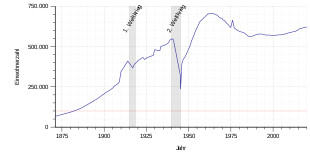
Population development of Düsseldorf from 1871 to 2019
Religions
See also: List of sacral buildings in Düsseldorf
According to a religious study by the Ruhr University in Bochum, Düsseldorf is the most non-religious city in North Rhine-Westphalia. In 2006, 35.5% of Düsseldorf's inhabitants did not belong to any organized religious community. Thus, even at that time, the non-denominational represented the largest group in the city's population, ahead of the Catholic and Protestant churches.
Denomination statistics
At the end of 2018, 28.6% of the inhabitants were Roman Catholic, 16.9% Protestant. 54.5% belong to other denominations or religions or are non-denominational. With around 7,000 members, Düsseldorf has the third-largest Jewish community in Germany after Berlin and Munich. According to the results of the census on May 9, 2011, 202,370 residents of Düsseldorf belonged to the Catholic Church. 131,880 residents were Protestant, 2,900 Evangelical Free Church, 20,260 Orthodox and 4,560 Jewish. 220,790 inhabitants were assigned to the categories "Other" or "Not belonging to any religious community under public law." According to a calculation from the census figures for persons with a migration background, the proportion of Muslims in the population of Düsseldorf in 2011 was 8.3% (around 48,900 persons).
Christianity
Roman Catholic
From the beginning, Düsseldorf belonged to the archdiocese of Cologne and was under the archdeaconry of the cathedral dean. Although the Reformation initially gained a majority foothold, Catholics continued to remain in the city. They belonged to the deanery of Neuss until 1627, when Düsseldorf itself became the seat of a deanery. The early demise of the Grand Duchy of Berg in 1813 prevented the founding of a diocese of Düsseldorf, which had been suggested by Napoléon. Duke Wolfgang Wilhelm of Palatinate-Neuburg had already striven for such a bishopric for his main residence.
Since 1394, Apollinaris of Ravenna, whose relics rest in the Apollinaris shrine of the city church of St. Lambertus, has been venerated as the patron saint and city patron of Düsseldorf. On the occasion of his name day on July 23, the Düsseldorf Schützenfest is held with the largest fair on the Rhine. A lesser known highlight of these celebrations is the procession with the Apollinaris shrine. Significantly more people take part in the central Corpus Christi procession of all Düsseldorf parishes (except the deanery of Benrath) through the Old Town and Carlstadt.
In 2013, about 191,000 Catholics lived in Düsseldorf, which corresponded to a population share of about 32%. At the end of 2018, 28.6% of the inhabitants were Roman Catholics. Due to a shortage of priests and a decline in church membership, the cooperation of several parishes in pastoral areas began in the 1980s. Today, Düsseldorf has the following parish associations
- Cath. parish community Angerland/Kaiserswerth with the parishes St. Agnes, St. Lambertus, St. Remigius and St. Suitbertus,
- Parish association Flingern/Düsseltal with St. Elisabeth and Vinzenz, St. Maria Himmelfahrt and St. Paulus,
- Seelsorgebereich Unter- und Oberbilk, Friedrichstadt und Eller-West mit St. Antonius, St. Apollinaris, St. Josef, St. Martin, St. Peter und St. Pius X.,
- Parish community Eller-Lierenfeld with St. Gertrud, St. Michael and St. Augustinus,
- Seelsorgeeinheit Düsseldorfer Rheinbogen with St. Maria Rosenkranz, St. Maria in den Benden, St. Nikolaus, St. Joseph and St. Hubertus and
- Parish association Benrath-Urdenbach with St. Cäcilia and Herz-Jesu.
Another nine of the total of 33 Düsseldorf parishes, i.e. St. Lambertus Düsseldorf, St. Trinity, St. Anthony and Benedictus, Holy Family, St. Francis Xavier, St. Margaret, St. Boniface, St. Anthony and Elizabeth, and St. Matthew, were created by merging neighboring parishes and, like the pastoral areas, extend over several city districts. All parishes except one belong to one of the five deaneries North, Central/Heerdt, East, South and Benrath in the city deanery of Düsseldorf. The city dean is usually the pastor of St. Lambertus. A special case is the parish of St. Mary's Assumption in Unterbach, which has a dependence in neighboring Erkrath-Unterfeldhaus and has formed a pastoral community with St. John the Baptist in Erkrath in the Hilden deanery, Mettmann district deanery of the Archdiocese of Cologne since January 1, 2010.
Since 2006, the Catholic City Association has maintained the Maxhaus in Carlstadt next to the Maxkirche as a Catholic meeting and event center with religious as well as cultural and musical offerings.
Evangelical-United
The Reformation was able to partially establish itself from 1527, favored above all by the reform Catholicism of Duke William V. In addition to the singing of psalms, communion in both forms was introduced in the collegiate church of St. Lambertus. This was the foundation of the Lutheran congregation. In 1571 there was another change at the court, according to which the Protestants were suppressed. The Lutheran congregation and the Reformed congregation, founded in 1573, met secretly thereafter until the suppression ended from 1590. From 1609, the Protestants were initially able to hold their services in public: the Reformed in their preaching house on Andreas Street, the Lutherans on Berger Street. In 1614, under the Roman Catholic ruler Wolfgang Wilhelm, suppression resumed. Until the middle of the 17th century, the Protestants could only hold their services secretly. Then they received the right to practice their religion freely. The first surviving Protestant sermon in Düsseldorf was held in the Predigthaus on Bolkerstraße, which has been preserved from 1651. In 1683, the Reformed congregation was able to build its own church, which was named Neanderkirche in 1916. The tower was completed in 1687. In the same year, the Lutheran church on Berger Street was built. If the Protestant community of Düsseldorf initially belonged to the Cologne class, later to the Berg Synod (1589), Düsseldorf became the seat of its own class (church administration district) in 1611.
After the transfer to Prussia in 1825 (→ about the union in Prussia: Agendenstreit), the two Protestant parishes united to form the "Evangelische Gemeinde Düsseldorf," which belonged to the Düsseldorf superintendency. As early as 1815, Düsseldorf had become the seat of the Prussian chief consistory of the province of Jülich-Kleve-Berg, but this moved to Cologne as early as 1816. In 1827, there was a synod in Düsseldorf.
Düsseldorf's Protestant congregation grew steadily and more churches were built, such as the Johanneskirche on Martin-Luther-Platz (1881), the Christuskirche (1899), the Friedenskirche (1899) and the old Matthäikirche (1899) as well as the Kreuzkirche (1910). In 1905, the parish of Eller-Wersten was formed from parts of the parishes of Urdenbach and Gerresheim. As a result of incorporations, there were further parishes in the city area. On October 1, 1934, the seat of the consistory of the Rhenish Provincial Church of Prussia and the Evangelical Church in the Rhineland, respectively, was moved from Koblenz to Düsseldorf. Today's church administration is in Hans-Böckler-Strasse in the Golzheim district. Furthermore, there is a "House of the Church" in Bastionstraße in Carlstadt. In 1936, an overall association was founded for all Düsseldorf Protestant congregations. In 1948, the Düsseldorf parish was split up. There were also changes in the parishes in the outer districts.
In 1964, the Düsseldorf church district was divided into the church districts of Düsseldorf-Mettmann, Düsseldorf-North, Düsseldorf-East and Düsseldorf-South, with the Düsseldorf-Mettmann church district comprising mainly church congregations outside the city of Düsseldorf. Until mid-2007, the three church districts in the city area formed the Düsseldorf church district association within the Evangelical Church in the Rhineland. On June 16, 2007, the synod of the newly formed Düsseldorf church district met for the first time. It resulted from the merger of the church districts of Düsseldorf-North, Düsseldorf-East and Düsseldorf-South and represents 24 Protestant congregations and thus 116,550 Protestants in the state capital, who made up about 20 percent of the population in 2013. At the end of 2018, 16.9 percent of the population was Protestant.
Because of the decline in church membership and attendance, more and more churches are being closed; since 2001, Protestants have deconsecrated 20 of the 49 churches.
See also: Diakonie Düsseldorf
Evangelical Lutheran
In response to the unification of the Evangelical Lutheran Church in Prussia and some Reformed congregations into the Uniate Evangelical Church in Prussia by cabinet order of King Frederick William III in 1817 and 1830, the Evangelical Lutheran (Old Lutheran) Church of Prussia was formed. The Old Lutherans insisted on recognition of the Lutheran confession. They demanded unrestricted Lutheran worship, constitution and doctrine. After a hard period of persecution on the part of the state and with the approval of the new Lutheran Church of the Union, they were able to constitute themselves in 1841 under King Frederick William IV and were recognized. From 1844 Lutheran services were again celebrated in Düsseldorf in a congregation consisting of Lutherans from the congregation before the forced union as well as immigrants from Saxony and Bavaria. In 1882 the congregation consecrated its own house of worship in Kreuzstraße, which fell victim to an air raid on June 12, 1943. In 1884, the congregation was recognized as a legal entity by the Prussian state. Since the property in Kreuzstraße could not be built on after the war for urban planning reasons, the congregation acquired its current property and consecrated its Redeemer Church in Eichendorffstraße in Stockum on April 2, 1956. Today, the parish belongs to the Rhineland church district of the Independent Evangelical Lutheran Church (SELK). Silvia Sommerlath, the future Queen Silvia of Sweden, was also confirmed in this parish by Superintendent Nagel.
Orthodox churches
Düsseldorf is home to the Commission of the Orthodox Church in Düsseldorf with parishes of the
- Greek Orthodox Church in Hassels, Am Schönenkamp,
- Georgian Orthodox Church in Hamm on Ferry Street, it celebrates its services in the Jan Wellem Chapel,
- German-speaking Orthodox Parish of the Holy Archangels in Wersten, Werstener Feld,
- Russian Orthodox Church,
- Romanian Orthodox Church and Serbian Orthodox Church,
- Copticchurch in Grafenberg on the Pöhlenweg and
- Ukrainian Orthodox Church.
Anglicans and Old Catholics
The Anglican Church, which is in full church fellowship with the Old Catholic Church, is located with a congregation in Rotterdamer Straße at Nordpark. The parish church of the Old Catholic parish of Düsseldorf is the Thomaskirche, the former Klarenbach Chapel in Steubenstraße in Reisholz.
Free Churches
In addition to the major Christian denominations, numerous free churches are also represented with congregations in Düsseldorf. These include the
- Apostolic Community with its German headquarters and the main congregation in the city center on Cantadorstraße as well as the congregation in Eller (Klein Eller),
- Pentecostal movement with the Christian Center Düsseldorf on Bruchstraße in Flingern,
- Baptists with the congregations on Luisenstrasse in Friedrichstadt and Ackerstrasse in Flingern, and the Christophstrasse Evangelical Free Church congregation on Werstener Strasse in Bilk,
- Protestant Methodist Church in the Matthias Church in Lichtenbroich,
- Free evangelical congregation in the city center on Bendemann Street,
- Salvation Army,
- Moravian Church in Heerdt,
- Pentecostal movement in the Jesus-Haus on Grafenberger Allee and
- Mosaic community currently in Derendorf.
The Düsseldorf congregations held a Free Church Day in the Robert Schumann Hall in 1990 and in the Südpark in 2001.
Jehovah's Witnesses
The special Christian communities also include Jehovah's Witnesses, who are represented by 18 assemblies (congregations) and four groups in Düsseldorf. Meetings (church services) are held in five Kingdom Halls in the Düsseldorf city area. The largest hall center (with four halls) is located in Flingern-Süd. Here, in addition to several meetings in German (two meetings), meetings are also held in English, Russian, Polish, Greek, Italian, Romanian, Croatian/Serbian, Tagalog, Chinese and German sign language. In the Kingdom Hall Center Eller (with two halls), meetings are held in Russian, Spanish, Hindi and Twi, in addition to German. Other Kingdom Halls are located in Oberkassel, Pempelfort and Hellerhof. Here, meetings are held in German (three meetings), Japanese and Vietnamese. In addition, several special events, such as a Bible exhibition, are held, preferably open to the public, in the Flingern-Süd Kingdom Hall.
Other churches and special Christian communities
Furthermore, the Christian Community, the Church of Jesus Christ of Latter-day Saints (Mormons), and the New Apostolic Church are represented in Düsseldorf with five congregations in Benrath, Derendorf, Eller, Flingern and Gerresheim. In addition, there is the Russian-speaking Jewish-Messianic congregation Beit Hesed in Düsseldorf, which also publishes the German-language magazine Kol Hesed.
Judaism
→ Main article: Jewish life in Düsseldorf
The Jewish community of Düsseldorf is the largest in North Rhine-Westphalia and the third largest in Germany with about 7500 members. The new synagogue was inaugurated in 1958 and is located in Zietenstraße in the Golzheim district. It is guarded around the clock by the police. Predecessor buildings were the old synagogue and the Great Synagogue in Kasernenstraße on the present site of the Handelsblatt publishing house, which was set on fire during the November pogroms in 1938 and subsequently demolished.
As a public corporation, the municipality is a unitary municipality according to its statutes. This means that all religious directions are respected. The services are in accordance with the Orthodox rite. Until July 2011, the rabbi was Julien Chaim Soussan, one of the youngest congregational rabbis in Germany. 90% of the congregation members come from the former Soviet Union. The community includes a kindergarten and an elementary school, the Yitzhak Rabin School. It is a state-approved elementary school and a Jewish denominational school that provides kosher food for the children. In a statewide comparative study, the school was found to be among the top 25 elementary schools in the state of North Rhine-Westphalia. The community also has a sports club (Maccabi), a youth center and a cemetery.
Islam
There are also a number of Muslim communities in the state capital. However, these do not form a uniform association, but are organized as Turkish, Bosnian, Moroccan and other mosque associations according to the national affiliation of their members. The largest Turkish association, the Türkisch-Islamische Union der Anstalt für Religion e. V., has three mosques in Düsseldorf. They are located in Lörick, Eller and Derendorf. In total, there are around 20 mosques in Düsseldorf. According to the various sponsoring associations, the Friday prayers are attended by around 4,000 worshippers, with the two largest mosques in Derendorf and Flingern accommodating up to 1,000 participants. Sermons are held in Turkish, Arabic, Berber, Bosnian, Albanian, Romani and German, among other languages.
Alevis are also represented in Düsseldorf with a congregation in the Eller district. The country of origin of almost all Alevis is Turkey. In addition to religious work, the Düsseldorf community also implements cultural and musical projects. In North Rhine-Westphalia, the Alevi community in Germany has the status of an independent religious community recognized under the Basic Law and helps coordinate Alevi religious instruction as a regular school subject. The Alevis in Düsseldorf also belong to this umbrella organization.
Buddhism
In the Niederkassel district on the left bank of the Rhine, the only Buddhist temple in the Jōdo-Shinshū tradition in Europe is located on the site of the Japanese Ekō House. It is built in Japanese style as a concrete structure and surrounded by a Japanese garden. The Japanese in Düsseldorf established the Japanese Cultural Center with the Ekō House in 1993. It is also a traditional Japanese house for tea ceremonies, has a library and a kindergarten.
Furthermore, there are a number of Buddhist centers in Düsseldorf of all notable traditions of Buddhism. A selection: Rigpa (Tibetan Buddhism, teacher Sogyal Rinpoche), Amitabha Foundation (also Tibetan Buddhism) as well as Kanzeon Sangha (Zen tradition) and Diamond Way Buddhism (Lama Ole Nydahl) as well as other Buddhist groups and centers. Thus, the Buddhist groups in Düsseldorf offer a wide range in North Rhine-Westphalia.

Neander Church
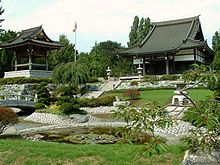
Ekō House

The New Synagogue

Kingdom Hall of Jehovah's Witnesses

Apostolic congregation
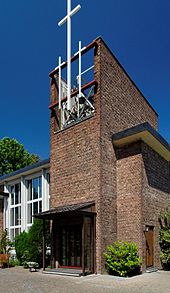
Church of the Redeemer in Stockum
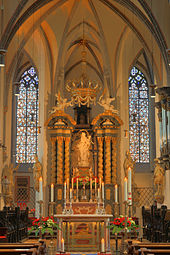
St. Lambertus with Apollinaris shrine
Politics
At the head of the city of Düsseldorf in the 13th century were the Schöffen, who until 1806 were the highest and most powerful class in the city administration. Since 1303 a mayor is mentioned, who was initially also a Schöffe. In addition, from 1358 there was also a council, which was partly divided into an Old Council and a Young Council. The members were either elected for life (Old Council) or appointed annually (Young Council). As a ducal representative, a Schultheiss was also involved in the administration of the town, who held the title "Amtmann". Since about the 15th century, in addition to the above-mentioned bodies, there was also a municipal committee of 12 people ("Zwölfer"), which took part in the election of the mayor and was consulted on important decisions, but actually did not represent real citizen participation. It was not until the French period that there was a Munizipalrat, and from 1815 a Gemeinderat with 30 members. Since 1856 it was the "city councillors", later aldermen, whose total number changed several times. During the French period, the town was governed by the mayor, who was assisted by three aldermen. Since Prussian times, the head of the city bore the title of Lord Mayor. In 1856, the Rhenish town code was introduced.
During the National Socialist era, the Lord Mayor was appointed by the NSDAP. After the Second World War, the military government of the British occupation zone appointed a new Lord Mayor and introduced the municipal constitution based on the British model in 1946. Thereafter, there was a "Council of the City" elected by the people, whose members were called "City Councillors." The council initially elected the mayor from among its members as chairman and representative of the city, who held his office on an honorary basis. Furthermore, starting in 1946, the Council also elected a full-time Lord Mayor as head of the city administration. In 1999, the dual leadership in the city administration was abandoned. Since then, there has only been a full-time Lord Mayor. He is chairman of the council, head of the city administration and representative of the city. He was elected directly by the citizens for the first time in 1999.
Since January 2021, the CDU and the Greens have been in coalition in the city council.
Lord mayor since 1815
The Lord Mayor is elected by the citizens in a general, direct, free, equal and secret election in accordance with the provisions of the Municipal Code for the State of North Rhine-Westphalia. Since October 1, 1999, the full-time Lord Mayor has headed the city and is the chairman and representative of the council of the municipality. The Lord Mayor heads the city administration, in which he is assisted by the City Manager, the Treasurer and five full-time aldermen.
The City Council elects three honorary deputies who bear the designation "Mayor". In Düsseldorf, the general deputy of the Lord Mayor bears the designation "Stadtdirektor" (City Director).
- 1815-1820: Engelbert Schramm
- 1820-1822: Lambert Josten
- 1822-1824: Joseph Molitor
- March-October 1824: Leopold Custodis
- 1824-1828: Friedrich Adolf Klüber
- 1828-1833: Philipp Schöller
- 1833-1848: Joseph von Fuchsius
- 1848–1849: Wilhelm Dietze
- 1849: Ludwig Viktor von Villers
- 1849-1876: Ludwig Hammers
- 1876–1886: Wilhelm von Becker
- 1886-1899: Ernst Heinrich Lindemann
- 1899-1910: Wilhelm Marx
- 1911-1919: Adalbert Oehler
- 1919-1924: Emil Köttgen
- 1924-1933: Robert Lehr, DNVP
- 1933-1937: Hans Wagenführ, NSDAP
- 1937: Otto Liederley, NSDAP
- 1937-1939: Helmut Otto, NSDAP
- 1939-1945: Carl Haidn, NSDAP
- April 3-17, 1945: Werner Keyßner, NSDAP
- April 17 - September 18, 1945: Wilhelm Füllenbach
- 1945–1946: Walter Kolb, SPD
- 1946-1947: Karl Arnold, CDU
- 1947-1956: Josef Gockeln, CDU
- 1956-1959: Georg Glock, SPD
- 1960-1961: Willi Becker, SPD
- March 28 - November 17, 1961: Fritz Vomfelde, CDU
- 1961-1964: Peter Müller, CDU
- 1964-1974: Willi Becker, SPD
- 1974-1979: Klaus Bungert, SPD
- 1979-1984: Josef Kürten, CDU
- 1984-1994: Klaus Bungert, SPD
- 1994-1999: Marie-Luise Smeets, SPD
- 1999-2008: Joachim Erwin, CDU
- 2008-2014: Dirk Elbers, CDU
- 2014-2020: Thomas Geisel, SPD
- since 2020: Stephan Keller, CDU
See also: List of mayors of Düsseldorf 1303-1806
| Election of the Lord Mayor of Düsseldorf 2020 in percent % 60 50 40 30 20 10 0 34,2 % 26,3 % 17,4 % 12,5 % 2,7 % 2,2 % 1,2 % 0,9 % 0,8 % 0,5 % 0,4 % 1,0 % Dr. Keller Geisel Engstfeldl Dr. Strack-Zimmermann Hoffmann Bonn Mirus Schenk Kruger Dr. Grumbach Coldewe Otherwise. | Run-off election in percent % 60 50 40 30 20 10 0 56,0 % 44,0 % Dr. Keller Geisel |
Chief city directors 1946-1999
- 1946: Walter Kolb
- 1946-1964: Walther Hensel
- 1964-1976: Gilbert Just
- 1976-1987: Gerd Högener
- 1987-1994: Karl Ranz
- 1994-1999: Peter Hölz
City Council
→ Main article: Düsseldorf City Council
See also: Results of the municipal elections in Düsseldorf
| Council election 2020 - Düsseldorf Voter turnout: 52.57 % 40 30 20 10 0 33,4 % 24,0 % 17,9 % 9,2 % 4,1 % 3,6 % 1,8 % 1,8 % 1,4 % 0,9 % 0,9 % 1,1 % CDU Green SPD FDP Left AfD Volt PARTEI Animal welfare here! FW Climate Otherwise. Gains and losses compared to 2014 %p 12 10 8 6 4 2 0 -2 -4 -6 -8 -10 -12 −3,3 %p +10,2 %p −11,4 %p +2,2 %p −1,1 %p +0,6 %p +1,8 %p +1,8 %p +1,4 %p −0,3 %p +0,9 %p −2,8 %p CDU Green SPD FDP Left AfD Volt PARTEI Animal welfare here! FW Climate Otherwise. |
District representation
In each city district there is a district council with 19 members. The chairperson is called the district mayor. These 'district parliaments' were established in 1975 in order to increase the citizens' opportunities to influence and shape the city. The district councils are newly elected by the district residents at every municipal election for a period of five years.
The district representations are to be heard on important matters affecting the city district. In matters of the municipal district which are not a matter of current administration and for which the City Council is not exclusively responsible, the district councils shall decide in accordance with the Municipal Code, taking into account the interests of the entire city and within the framework of the general directives issued by the Council.
Municipality
The city administration is entrusted with all public tasks of the city and is headed by the mayor. The full-time aldermen and treasurer together with the mayor form the administrative board. The mayor presides over the board and decides in case of disagreement. The aldermen report directly to the mayor, they represent him in their department. The aldermen are municipal elected officials. They are elected by the Council for a term of eight years.
The administration conducts operational business and implements political goals on its own responsibility. In doing so, predictability, continuity and uniformity of decisions and administrative action must be ensured. The heads of the administration must be accountable to the elected city council. The delimitation of competences is defined in the city constitution.
The Düsseldorf administration is divided into nine departments. Various offices are assigned to the departments. The offices are the lowest organizational units of the administration. The largest locations where the many offices provide their services are the city hall complex around the market square in the old town, the service center on Willi-Becker-Allee near the main train station and the technical city hall in the Bilk district.
Debt
The total amount of debt of the city of Düsseldorf (of the public sector) at the end of 2012 was 872.2 million euros. That is 1478 euros per inhabitant. Of the 103 independent cities in Germany, Düsseldorf thus ranked 100th in terms of per capita debt; in other words, only three other independent cities had lower per capita debt.
For the 2014 financial year, the city of Düsseldorf has budgeted a budget surplus in ordinary income and expenses (including financial income and expenses) of EUR 3.1 million (EUR 5 per inhabitant) in the statement of comprehensive income. The city of Düsseldorf is thus one of only three independent cities in North Rhine-Westphalia (along with Krefeld and Münster) not to have a budget deficit in the statement of comprehensive income in 2014.
Coat of arms
|
| Shield: "In the silver shield the erect, double-tailed, blue-crowned and -armored red lion of the Dukes of Berg, holding a lowered blue anchor in his paws." |
| Coat of arms justification: The original coat of arms of the city of Düsseldorf - with the anchor only - was created at the same time as the city was elevated. The anchor refers to the relationship of the city and its citizens to the Rhine as well as to Rhine shipping and the Bergisch Rhine duty. From the end of the 17th century, this simple coat of arms was joined by a second one, which was modeled on the seal of the Düsseldorf College of Aldermen, which had been in use since the middle of the 16th century by order of the sovereign. It shows the Bergisch lion, the heraldic animal of the Bergisch dukes, holding the anchor in its paws. Around the middle of the 18th century, this elaborately designed image had finally replaced the older city coat of arms. After numerous modifications in the 19th and 20th centuries, the heraldist Otto Hupp freed the coat of arms from later ingredients in 1938 and gave it the form it has today. The associated city flag is red and white, covered with the coat of arms. |
Coat of arms
For private and business purposes, a city coat of arms was created in February 2002, which differs from the official city colors and can be used without the permission of the city administration. In the red-white divided shield there is a silver double-tailed, erect, silver-crowned and -armored lion with a lowered black anchor in its paws.
City logo
In official letters and publications, the city of Düsseldorf uses a logo that indicates the Rhine bends in the Düsseldorf city area in a square in the left half and shows the Bergischer Löwen with an anchor in the upper right quadrant. The city logo is used in various colors, with one hue assigned to each of the current eight departments.
Umbrella brand
In 2011, to improve its marketing and public perception, the city began a process of developing an umbrella brand. A brand core analysis was followed by a public competition that resulted in over 2,000 photo, video and text entries. In March 2012, a process of expressing interest in a creative agency competition began. The ensuing competition to develop the umbrella brand was won by the BBDO Proximity agency, which presented the logo of the new umbrella brand, the emoticon :D, to the public on November 26, 2012. The Düsseldorf "smiling :D" is in red, the color of the Bergisch Lion, and in Helvetica font. It has the particular task of conveying "the emotional, likeable Düsseldorf." The procedures for introducing the new umbrella brand and its logo were accompanied by public controversy.
Town twinning
Düsseldorf maintains eight classic city partnerships:
- United Kingdom
 Reading (United Kingdom), since 1947/1988
Reading (United Kingdom), since 1947/1988 - Germany
 Chemnitz (Germany, Saxony), since 1988
Chemnitz (Germany, Saxony), since 1988 - Israel
 Haifa (Israel), since 1978/1988
Haifa (Israel), since 1978/1988 - Poland
 Warsaw (Poland), since 1989
Warsaw (Poland), since 1989 - Russia
 Moscow (Russia), since 1992
Moscow (Russia), since 1992 - China People's Republic of
 Chongqing (China), since 2004
Chongqing (China), since 2004 - Italy
 Palermo (Italy), since 2016
Palermo (Italy), since 2016 - Japan
 Chiba (Japan), since 2019
Chiba (Japan), since 2019
Friendly relationship continues to exist:
- France
 Toulouse (France)
Toulouse (France) - Spain
 Tenerife (Spain)
Tenerife (Spain) - Canada
 Montreal (Canada)
Montreal (Canada) - China People's Republic
 Guangzhou (China)
Guangzhou (China) - China People's Republic
 Shenyang (China)
Shenyang (China)
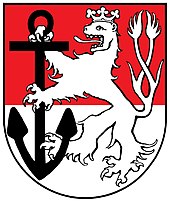
Coat of arms for everyone

City logo

Lord Mayor: Stephan Keller (CDU)
Economy and infrastructure
In the 2016 Future Atlas, the independent city of Düsseldorf ranked 21st out of 402 districts and independent cities in Germany, making it one of the places with "very high prospects for the future". In the 2019 ranking, it improved to 12th place out of 401.
Düsseldorf is an economically strong, diversified and globally intensively interconnected city in the center of the Rhine-Ruhr metropolitan region, in which it holds a functional primacy position (→ Global City). Among the metropolitan functions, the decision-making and control functions sector clearly outshines all districts and independent cities in North Rhine-Westphalia. In this sector, Düsseldorf ranks third in Germany after Munich and Berlin and ahead of Frankfurt am Main. Düsseldorf also has an outstanding function in North Rhine-Westphalia as a gateway, i.e. in terms of its long-distance infrastructures and global contacts. On the one hand, its central location in Germany's most densely populated conurbation is decisive for this. On the other hand, Düsseldorf Airport as Germany's third-largest airport and Messe Düsseldorf with 25 leading international trade fairs are important factors for the city's economic significance, especially with regard to its international integration. The strong position of Düsseldorf's labor market is manifested in by far the largest commuter surplus among the districts and independent cities of North Rhine-Westphalia (on balance +151,387 employees subject to social insurance contributions). The favorable location climate for economic innovation and business start-ups can be seen in the relatively high number of newly founded companies. In 2009, Düsseldorf was the leading city in Germany for new business start-ups, characterized by start-ups primarily in research-intensive industries. In 2011, the city was the German location with the most direct investments from abroad. The number of jobs created by foreign investment was three times higher in 2011 than in 2010 and the highest within Germany. Thus, Düsseldorf was also the most popular location for foreign investment in Germany according to this parameter. According to a study by the consulting firm Ernst & Young, in 2013 Düsseldorf was the metropolitan area with the highest number of direct investments from the People's Republic of China in Europe - ahead of London and Paris. In 2014, the Düsseldorf region recorded the most foreign direct investment in Europe after London and before Paris. The strong growth of Chinese investments is explained on the one hand by the locational advantages offered by the technology companies existing in North Rhine-Westphalia, the central location in Europe and the trade fair venue, and on the other hand by the momentum of an already existing Chinese community that is settling in and establishing closer networks. Well-known Chinese companies that have established headquarters in Düsseldorf include Huawei Europe, Oppo Europe, Vivo Germany and Xiaomi Germany.
Düsseldorf is a leading location in the advertising, European patent, telecommunications, management consulting and art trade sectors, as well as Germany's "City of Fashion". With the Igedo Fashion Fairs and the Collections Premiers Düsseldorf (CPD), leading fashion fairs in Europe were held here. With the new format The Gallery Düsseldorf, trade fair organizer Igedo is attempting to build on earlier successes. More than 600 showrooms of various manufacturers as well as large textile trading companies are concentrated in the state capital, more than 1,300 in the Düsseldorf agglomeration. The spatial focus here is a cluster of order offices around Kaiserswerther Strasse in the Golzheim district. Düsseldorf continues to be Germany's number one fashion location in terms of sales: at around 18 billion euros, fashion sales in Düsseldorf were more than twice as high as in Munich and Berlin combined, according to a study by the Cologne Institute for Retail Research in 2013. The sobriety and business efficiency of the fashion location on the Rhine are appreciated.
In 2011, the city's cultural and creative industries comprised some 4,100 companies with annual sales of around 7.4 billion euros; according to a survey for 2008, the creative class's share of employees subject to social insurance contributions is highest in Düsseldorf among the districts and independent cities of North Rhine-Westphalia. Within Germany, the closely intertwined Rhine-Ruhr metropolitan region is considered the leading center of the creative industries.
Numerous international companies have their headquarters here: L'Oréal Germany, Komatsu Mining Germany, Air Liquide Germany, Nikon Germany, Vodafone Germany, Metro AG, Rheinmetall, Henkel, Tata Steel with Vallourec & Mannesmann Tubes, E-Plus and Qiagen. Daimler produces the closed series of the Mercedes-Benz Sprinter in Düsseldorf as well as the technically related Crafter for VW. Numerous medium-sized companies in the fields of high technology, medical technology, special machinery and plant engineering as well as drive and production technology and food production have been an integral part of Düsseldorf's industrial landscape for decades. These include the companies Gerresheimer AG, Demag Cranes AG, Vossloh AG, GEA Group AG, A.u.K. Müller GmbH & Co. KG, Walter Flender Group and Zamek. The largest Japanese colony in continental Europe has earned Düsseldorf the nickname "Nippon on the Rhine". However, companies from other countries are also active in the city to a considerable extent - especially from the Netherlands, Great Britain, France, Scandinavia and China. The economic center of the Japanese community is Immermannstrasse, which attracts tourists and locals alike with its various Japanese restaurants, stores and supermarkets.
Since the turn of the millennium, Düsseldorf has also seen the development of a lively startup scene in the Internet industry, although it cannot yet compete with cities such as Berlin, Hamburg and Munich. Among the best-known Düsseldorf startups are the hotel search engine Trivago and, in the FinTechs sector, Auxmoney.
Düsseldorf's economic strength has helped the city achieve solid municipal finances with balanced budgets since 1999. In 2007, the city became the second major city in Germany to be debt-free. In 2005, Düsseldorf also became the first German city to undergo a credit rating, receiving an Aa1 rating from the rating agency Moody's, the second-best possible rating. Düsseldorf's creditworthiness was thus rated higher than that of North Rhine-Westphalia (Aa2), Deutsche Bank (Aa3) or Commerzbank (A2), for example.
In 2012, the gross domestic product in Düsseldorf was 41.5 billion euros. That is a share of 7.1 percent of the gross domestic product of North Rhine-Westphalia in 2012. The GDP per employee in Düsseldorf in 2012 was 82,667 euros - 125.3 percent of the value for the whole of North Rhine-Westphalia. In a nationwide comparison of cities, this puts the city together with Frankfurt am Main at the top of the list in Germany. The purchasing power index for the state capital is around 20 percent above the national average in a long-term comparison. Despite the differentiated economy and the good framework conditions, unemployment has been higher than the national average for years, which is related to the loss of more than 50,000 jobs in industry and manufacturing over the past 30 years. In 2014, the city's debt amounted to 383 million euros.
The city's business, office and administrative locations have been distributed throughout the city with the urban planning goals of relieving congestion in the city center, unbundling traffic, taking advantage of more favorable land prices and creating urban development impulses. In addition to the city center, the following areas are considered the most important office and administrative locations:
- Media harbor/government district
- Kennedydamm-Golzheim/northern Derendorf
- Oberkassel/Seestern
- Oberbilk/International Trade Center
- Airport/Düsseldorf Airport City
- Mörsenbroich egg and
- Grafenberger Allee.
Düsseldorf, the top real estate location within the Rhine-Ruhr metropolitan region, attracts high-quality real estate development and investment, both in the commercial and residential sectors, due to its intrinsic value and good demographic and economic prospects. Due to its importance for the real estate market, the consulting firm bulwiengesa classifies the city alongside six other German metropolises in the group of so-called A-cities. According to a study by CBRE, Düsseldorf was one of the top ten investment markets for commercial real estate in Europe in the first half of 2013. In 2015, the total value of commercial real estate sold exceeded the three billion euro mark for the first time. Population growth (primarily due to an influx of new citizens) and rising occupancy of residential space by older people could increase demand for residential space by a total of 3.1 percent between 2006 and 2025. The gentrification promoted by individualization and metropolization, which is realized in the housing market of neighborhoods in high demand as the displacement of low-income milieus by new residents with higher incomes, is increasingly leading to a housing policy debate in the city. The strong demand for housing is offset by a low number of vacant apartments and a low number of new apartment buildings, which drives up housing prices. According to housing market observers, this situation, which will persist for the time being, results in an optimal economic environment for high-yield investments, particularly investments in modern-design, high-quality new multi-story residential construction, especially since, as a result of the low level of new construction in recent decades, about 81 percent of the housing stock is now older than 30 years. Measured against the average net household income of Düsseldorfers, however, rents in the city are low by metropolitan standards. A study published in October 2012 by the German Real Estate Association found, with regard to a three-room rental apartment with 70 square meters in a mid-range location as a reference, that a Düsseldorf household spends an average of 19.8 percent of income on it, but an average Berlin household spends 23.0 percent. In 2013, the Deutsche Bundesbank reported that the price trend in housing markets in major German cities, notably also in Düsseldorf, may have led to "exaggerations". As a result of the financial and global economic crisis, several trends overlapped in Düsseldorf in recent years to generate exceptionally high purchase and rental price increases for residential real estate, especially in inner-city locations: a trend back to the city (reurbanization), municipal liberalization efforts, negative real interest rates, the "flight" of private investors into real assets, poor investment alternatives for low-risk investments by institutional investors and some population growth.
Traffic
Düsseldorf has a dense transportation infrastructure. This is due in particular to the good facilities for local public transport and motorized private transport. In addition, the smaller size of the city and its location in a polycentric spatial structure with good transport links significantly reduce the likelihood of traffic congestion. With regard to accessibility potentials in road and rail transport, the Rhine-Ruhr metropolitan region, in the center of which Düsseldorf is located, had the top position of the regions examined in northwestern Europe in 2001. This contrasts, for example, with a comparison by the management consultancy Arthur D. Little, which sees Düsseldorf in last place in terms of the coordination and networking of the local public transport systems of major German cities.
Air traffic
→ Main article: Düsseldorf Airport
In terms of passenger numbers, Düsseldorf Airport is Germany's fourth-largest international airport after Frankfurt Airport, Berlin Brandenburg Airport and Munich Airport. In 2012, around 20.8 million people flew with 60 different airlines to and from 200 destinations in over 50 countries worldwide. The airport is characterized by its proximity to the city center as well as to the exhibition center in Stockum, its direct connection to the highway network and its very good connection to the railroad network, which is why short transfer times to the city area and the region are possible.
Shipping and ports
With the port close to the city center in the district of the same name and the Reisholz port, the expansion of which has been planned for a long time, two transhipment points for goods are available to Rhine shipping in the city area. Via the Rhine, the associated canals and the Main-Danube Canal, Düsseldorf is extensively connected to the European inland waterway network - including the Ems, Weser, Elbe, Oder and Danube - and to important seaports on the North Sea and the Black Sea. For water sports enthusiasts, there is a sports and yacht harbor at Rheinpark Golzheim.
Passenger ships of the White Fleet Düsseldorf, which were operated by the Rheinbahn before 1993, run regularly between the old town and Kaiserswerth. The Köln-Düsseldorfer Rheinschifffahrts AG (kd) also has landing stages in the city area. With the Rhine ferry Langst-Kaiserswerth and the ferry between Urdenbach and Zons, two car ferries are still in operation. A third car ferry operated between Himmelgeist and Uedesheim until the Fleher Bridge was opened in 1979. Today, a passenger ferry with bicycle transport operates here on Sundays in good weather. For some years now, passenger ferries have also been operating between the Rheinkirmes and the old town.
Urban road traffic
The federal highways B 1 and B 8 cross the city area in a north-south direction and the federal highway B 7 in an east-west direction. They owe their present course and character to
- of the Theodor Heuss Bridge, completed in 1957,
- ring-shaped streets running around the city center between the North and South Cemeteries, which were developed into the so-called Lastring,
- the new B 8 between Golzheim and the Duisburg-Süd interchange, which is called Danziger Straße, and
- the Rhine bank tunnel, which has been in operation since December 15, 1993.
The B 228 connects Benrath with Hilden, Haan and Wuppertal. Today, all federal highways in the city area primarily serve urban through traffic and traffic to and from the autobahns, which have taken over the role of federal highways in the trunk road network outside the city area. With the exception of the B 7 and B 228 to Wuppertal, the designation of the federal highways therefore still ends in the city area or just beyond it. One example is the former B 8 between Wersten and Hellerhof and on to Opladen. Parallel to it runs Münchener Straße and Frankfurter Straße, a four-lane motor road between Bilk and Garath. Its construction was started in the 1960s in order to cope with the multiplying car traffic to the rapidly growing or new districts in the south of Düsseldorf.
Traffic planning after the Second World War was initially shaped by Friedrich Tamms, an advocate of the car-oriented city. In addition to some of the construction projects already mentioned, the Rheinknie Bridge and the Oberkassel Bridge, he planned a third efficient north-south traffic axis between Golzheim and Wersten. Berliner Allee and the adjoining elevated highway to the north - also known as Tausendfüßler, demolished again in April 2013 and replaced by tunnel structures under the Kö-Bogen - were the central projects on this axis and were built between 1954 and 1962.
Highways
The A 3 between Frankfurt am Main and Oberhausen runs to the east outside the city area and was the nearest freeway until the end of the 1960s. Its first section between Mettmann and Cologne-Mülheim was opened as early as 1936. Initially, it could only be reached via today's B 7. The northern feeder road was created between 1950 and 1960 when the B 1 between today's Mörsenbroicher Ei and the Breitscheid intersection was converted into a motorway. The southern feeder road - a motorway designated as the B 326 between Wersten and today's Hilden interchange - was added in 1956.
The A 57 between Cologne and Nijmegen is the second north-south connection within reach of the city, has existed since 1986, the section between Neuss and Cologne since 1966 (freeway from 1970) and was initially only accessible via today's Josef Cardinal Frings Bridge.
The A 52 is divided into two sections in the Düsseldorf metropolitan area. The northern section between the Düsseldorf-Rath junction and the Essen-Ost interchange corresponds up to the Breitscheid junction to the Nördlicher Zubringer, which was upgraded to a freeway in 1971. Today, the western section extends between the Büderich junction and Roermond, is the continuation of the B 7 in a westerly direction and links the city to the A 57 via the Kaarster junction. The first section up to the Neersen interchange was opened in 1971 and upgraded to a freeway in 1973.
The A 59 between the Düsseldorf-Süd interchange and the Leverkusen-West interchange runs parallel to the A 3, relieving the latter but also providing a better link between Monheim, Langenfeld and Leverkusen and Düsseldorf, and was built between 1968 and 1973.
The A 46 between Heinsberg and the Wuppertal-Nord junction tangents the city center to the south, links the Heinrich Heine University to the highway network and since 1986 has provided a seamless cross-connection between the A 3, A 59 and A 57. Sections were opened in 1979 after completion of the Fleher Bridge and in 1983 with the opening of the university tunnel. The southern feeder road was upgraded to a freeway as early as 1972.
The A 44 between Aachen and Velbert runs through the northern parts of the city and since the opening of the airport bridge in 2002 has provided a seamless cross-connection between the A 3, A 52 and A 57. The direct connection of the trade fair center, ESPRIT arena and the airport to the freeway network already took place in 1992, when an important section of the A 44 with a connection to the A 52 was opened at the Düsseldorf-Nord intersection.
The most recently built A 44 and A 46 freeways are the only interregional freeways in the Düsseldorf metropolitan area in an east-west direction. They cross the city area completely, which is why they relieve the remaining Rhine bridges and urban thoroughfares but also why four highway tunnels had to be built. Together with the A 3 and the A 57, they have formed the Düsseldorf beltway since 2002.
Driving bans
On September 13, 2016, the Düsseldorf District Government was ordered by the Düsseldorf Administrative Court to amend the Clean Air Plan, which has been in force since the beginning of 2013, so that it contains the measures required to comply with the limit value for NO2 as quickly as possible. The government's duty to protect health requires compliance with the limit value as quickly as possible. In view of the large proportion of emissions caused by diesel vehicles, the current clean air plan no longer meets this requirement: it must therefore be updated within one year. In this context, driving bans for diesel vehicles in particular would have to be seriously examined and weighed up.
Railroad traffic
Through the city area run the railroad lines
- Cologne-Duisburg (with ICE and EC/IC traffic)
- Mönchengladbach-Düsseldorf,
- Düsseldorf-Wuppertal,
- Düsseldorf-Essen (S-Bahn traffic only),
- Düsseldorf-Solingen (S-Bahn traffic only),
- Düsseldorf-Mettmann (S-Bahn traffic only) and
- Troisdorf-Mülheim-Speldorf (freight traffic only)
At the main station - the central long-distance train station, which has been at its present location since 1891 - these rail lines, with the exception of the freight line, are linked to each other, to the light rail system and to the rest of the local public transport system.
On the Cologne-Duisburg rail line near the airport is the Düsseldorf Airport train station, where in addition to the trains of an S-Bahn and all seven Regional Express lines, some of the ICE and EC/IC trains that run here also stop. Passengers and visitors to the airport can reach the terminals, which are just under 2.5 km away, by means of the SkyTrain. There, a second connection of the airport to the rail network exists via the underground terminal station Düsseldorf-Flughafen Terminal, via which a second S-Bahn line runs all day and individual trips of several regional express and further S-Bahn lines are extended at night.
Also on the Cologne-Duisburg rail line but in the south of Düsseldorf is the regional train station Düsseldorf-Benrath, where two regional express lines and one S-Bahn line stop all day. Also worthy of mention is Düsseldorf-Bilk station, located on the Mönchengladbach-Düsseldorf rail line, which is a busy transfer stop between three S-Bahn lines, the light rail trains running on the Wehrhahn line and the bus connections to Heinrich Heine University and will be upgraded to a regional station in the next few years.
Including the above-mentioned stations, there are 25 suburban train stations in the city area.
In rail freight transport, however, Düsseldorf is no longer a rail node following the closure and demolition of its Düsseldorf-Derendorf marshalling yard; the largest freight yard in the entire Düsseldorf rail complex is now at the station in neighboring Neuss.
See also: List of train stations in Düsseldorf
Public transport
→ Main article: Local public transport in Düsseldorf
Düsseldorf has a dense network of suburban rail, light rail, streetcar and city bus lines that are part of the Rhine-Ruhr Transport Association (VRR). The local public transport (ÖPNV) in the city area is operated by the Rheinbahn, the Regiobahn and the Deutsche Bahn. Düsseldorf's main station is served not only by the operator Deutsche Bahn, but also by other rail companies such as Abellio Rail NRW. All lines can be used here and also, if destinations are outside the city but in the VRR area, with tickets from the VRR. In addition, the NRW tariff applies and, for journeys to the greater Cologne area, also the tariff of the Rhine-Sieg Transport Association (VRS).
A tramway network was built up toward the end of the 19th century, initially with carriages pulled along the tracks by horses, then electrically from 1896. This rail network also included interurban lines to Krefeld (K-Bahn) and Duisburg (D-Bahn) as well as from Benrath to Solingen-Ohligs. Connections to Krefeld and Duisburg still exist today as light rail lines U 70 and U 76 (Krefeld) and U 79 (Duisburg). Further interurban lines exist to Neuss and Ratingen. With the successive expansion of the light rail network, the streetcar network was reduced from 19 (1981) to seven (2018) lines and to a route length of 70.2 kilometers.
The Düsseldorf light rail system currently comprises eleven lines. Seven of them run through the inner-city tunnel opened in 1988 between Heinrich-Heine-Allee subway station and the main train station. Another tunnel section for four new light rail lines, the Wehrhahn line, was opened on February 20, 2016. The Heinrich-Heine-Allee subway station is the central transfer point between all light rail lines. All tunnel lines have above-ground feeder lines, only some of which are equipped with independent or special rail bodies.
Regular bus services have also been operating in Düsseldorf since 1924. In addition to city bus lines within the urban area, long-distance lines (cf. regional bus services) provided connections to other cities, especially after operations were discontinued on some interurban streetcar lines. In the meantime, Rheinbahn has discontinued its line to Jülich and shortened other lines to Essen, Velbert, Solingen, Leichlingen, Opladen and Moers. Today, there are still connections to Mülheim an der Ruhr, Mettmann, Erkrath, Solingen-Ohligs, Langenfeld and Monheim; there are now even express buses to Haan. Today, 42 city bus lines and seven express bus lines operate in the city area. Bus lines are also an essential part of the night service on Friday to Saturday nights, Saturday to Sunday nights and on public holiday nights. Eight NachtExpress lines operate between 0 and 5 a.m. at 30- or 60-minute intervals. On August 20, 2018, service will begin on three Metrobus lines.
The first S-Bahn line outside the Berlin and Hamburg metropolitan areas was opened in 1967 between Garath and Ratingen. This was followed by the connection of the airport to the S-Bahn network in 1975 with the opening of the station under the terminal, the commissioning of the S8 - also known as the East-West S-Bahn - between the main stations of Hagen and Mönchengladbach on May 29, 1988, and the S28 between Kaarst and Mettmann on September 26, 1999. Following extensions of other lines, seven S-Bahn lines now operate in the city area.
See also: Düsseldorf light rail, Düsseldorf tramway and history of the Düsseldorf tramway
Bicycle and pedestrian traffic
Düsseldorf is connected to several national and international long-distance cycle routes, including the Rhine Cycle Route.
Since 2008, Düsseldorf's city center has had a bicycle rental system with a network character that is also suitable for one-way trips. The operator is the company nextbike. In 2011, 400 rental bikes are available at 58 marked stations in the city area. Pedelecs are rented at the bike station at the main train station.
The city of Düsseldorf is a member of the working group of pedestrian- and bicycle-friendly cities, municipalities and districts in North Rhine-Westphalia, which awarded it the title of "bicycle-friendly city" in 2007, even though the network of cycle paths is still considered by many citizens to be very patchy.
Düsseldorf is one of the few cities in Germany whose traffic signals for pedestrians have a separate yellow phase. Here, the yellow signal is marked by a rectangular yellow bar. During this time, pedestrians have the opportunity to clear the intersection without having to run against red, as in other cities. Immediately after the pedestrian signal changes from yellow to red, clearance for cross traffic is initiated. There is also a short red-yellow phase of less than one second duration for pedestrians before the green phase. A considerable number of traffic lights in Düsseldorf have already been converted to light-emitting diode technology, which should ensure lower maintenance requirements, clearer recognition and also lower energy consumption compared with incandescent lamps.
In Düsseldorf, Call-a-Bike rental bicycles may no longer be parked on public roads, such as sidewalks, since 2020. The city of Düsseldorf had ordered the operator to remove the entire fleet from public streets and to refrain from parking the bikes in the future.
See also: Benrather Straße (Düsseldorf)
Engineering, industry and manufacturing
Düsseldorf's tumultuous development into a major city was driven by the settlement of industrial companies in the 19th century. Today, the capital of North Rhine-Westphalia is still an industrial city. In 2005, the 1129 companies in the manufacturing sector (excluding construction and energy and water supply) generated around 29% of the taxable sales of all companies in the city, only slightly less than trade (approx. 32%) but significantly more than the service sector (approx. 9%). However, the importance of manufacturing has declined significantly in recent years. While Düsseldorf's industrial companies still provided 90,000 jobs in 1979, the number of employees in this sector had fallen to an annual average of only 38,791 by 2006, with a downward trend.
Düsseldorf's largest and best-known industrial enterprise is the Henkel Group, a chemical company that manufactures detergents and cleaning agents, cosmetics and personal care products, as well as adhesives, sealants and products for surface technology, and still produces in the Reisholz district. In the cosmetics and hygiene products sector, L'Oréal Deutschland GmbH, Marbert AG and Hakle-Kimberly Deutschland GmbH (Kimberly-Clark Corporation) are active in Düsseldorf. The medical technology and pharmaceutical sector is home to Gerresheimer AG, an MDAX-listed global company for high-performance glasses and biocompatible plastic products.
The metalworking industry has a long tradition. The best-known company from this sector was Mannesmann, which continued to produce in parts in Düsseldorf after its breakup, including Vallourec & Mannesmann Tubes (steel tubes). Also well-known is the Rheinmetall Group, Germany's largest arms manufacturer, based in Düsseldorf-Derendorf. Other metal processing companies include Schmolz + Bickenbach (stainless steel long products) and Hille & Müller GmbH. Since 2011, GEA Group AG, an internationally active company in the field of specialty mechanical engineering, has been headquartered in Düsseldorf.
In the vehicle technology, traffic and transport sector, the largest operation is the Mercedes-Benz plant in Derendorf, which produces and assembles the Mercedes-Benz Sprinter and the VW Crafter and manufactures CKD vehicles for the US Mercedes brand Freightliner. In Benrath, Demag Cranes produces port, terminal and rail cranes as well as automatically controlled transport vehicles and develops associated management and navigation software. Adjacent, Komatsu Mining Germany GmbH manufactures large hydraulic and mine hydraulic excavators. Demag Cranes and Komatsu Mining Germany are linked by their common origin in Carlshütte AG. Furthermore, Vossloh Kiepe GmbH manufactures control and drive systems for streetcars and trolleybuses as well as hybrid drives and special vehicles. The Walther Flender Group produces drive and conveyor technology. From the past, Schiess AG and DUEWAG are worth mentioning.
The paper industry is represented in the city by the companies Julius Schulte Söhne GmbH & Co. and the Stora Enso Group (formerly Feldmühle), which operated a production site in Reisholz until 2008 and now has its German headquarters in Düsseldorf. Guschky & Tönnesmann GmbH & Co. KG manufacture equipment for the paper and packaging industry.
From the food sector, Zamek Nahrungsmittel GmbH & Co. KG, Teekanne GmbH, Düsseldorfer Löwensenf GmbH as well as BASF Personal Care and Nutrition and Fortin Mühlenwerke are well-known. Today, however, the traditional Düsseldorf Altbier is no longer brewed in large brewery plants - except in home breweries. Instead, the large brewery sites in Derendorf and Heerdt are now conversion areas. Furthermore, Germany's largest manufacturer of compound feed, Deutsche Tiernahrung Cremer, is based in Düsseldorf.
Other well-known companies include SMS Siemag, which manufactures metallurgical and rolling mill technology, TELBA AG in the field of telecommunications and security technology, behr Labor-Technik GmbH, A.u.K. Müller GmbH & Co. KG, a company for solenoid valves, MHG Strahlanlagen GmbH and Carborundum-Dilumit Schleiftechnik GmbH (formerly Carbo Group), which manufactures grinding wheels.
Finance and insurance industry
The financial center of Düsseldorf is one of the largest in Germany, along with Frankfurt am Main, Munich and Stuttgart. In addition, Düsseldorf is an important German stock exchange city rich in tradition (Düsseldorf Stock Exchange). As a banking location with national and international importance, 83 credit institutions are represented in Düsseldorf with a branch or their headquarters. These include the traditional banking house HSBC Trinkaus & Burkhardt, NRW.BANK, Deutsche Apotheker- und Ärztebank, Deutsche Industriebank (IKB), Targobank, Sparda-Bank West, PSD-Bank Rhein Ruhr, Stadtsparkasse Düsseldorf, as well as many foreign banks such as BBVA, Wells Fargo and Crédit Mutuel. The major Japanese banks MUFG Bank, Mizuho Bank and Sumitomo Mitsui Banking Corporation all have their German headquarters in Düsseldorf. The North Rhine-Westphalia Banking Association and the Rhineland Savings Banks and Giro Association have their headquarters in NRW. The Cooperative Association has an administrative headquarters in Düsseldorf.
After all, Düsseldorf is home to some major insurance companies such as ERGO Insurance Group, ARAG Group, Provinzial Rheinland and Deutsche Rück. Two well-known FinTechs from Düsseldorf are Auxmoney and Compeon. In the field of auditing, Düsseldorf is an important location. The large, globally active auditing firms PwC, KPMG, Deloitte and EY maintain major offices in the state capital. Warth & Klein Grant Thornton has its German headquarters in Düsseldorf. In the management consulting sector, McKinsey maintains its German headquarters in Düsseldorf, while Accenture, Boston Consulting Group, Kienbaum and Bain & Company are also represented in Düsseldorf. In total, some 880 auditing firms with around 9,900 employees operate in Düsseldorf.
As a location for law firms, especially those specializing in commercial law, Düsseldorf is one of the most important locations in Germany. Among others, Hengeler Mueller, Freshfield Bruckhaus Deringer, Clifford Chance and White & Case maintain law firms in Düsseldorf. Taylor Wessing has its headquarters in Düsseldorf. In total, about 1,300 law firms maintain a location in Düsseldorf and employ about 6,000 people subject to social insurance contributions. Düsseldorf is also considered the most important court location for European patent disputes.
Trade and services
With the Metro Group and its subsidiary Metro Cash & Carry, one of the largest retail groups in the world is based in the capital of North Rhine-Westphalia. Furthermore, the headquarters of clothing stores such as Peek & Cloppenburg Düsseldorf (P&C) and C&A are located in the city area. As a location for the fashion trade and through the igedo and CPD trade fairs, the city has been able to acquire the reputation of a fashion city.
With around 1,500 companies and 24,000 employees, the information and communications technology sectors, and in particular the mobile communications industry, form a focal point of the city's economic structure. More than half of German cell phone and SIM card sales are controlled from Düsseldorf. Vodafone GmbH, the successor to Mannesmann Mobilfunk, is based in the city, as is E-Plus. Vodafone has also located its German and European headquarters in the Vodafone Campus in Düsseldorf-Heerdt on the left bank of the Rhine. In 2008, the Chinese telecommunications company Huawei moved its European headquarters from London to Düsseldorf. Here, the company is building its European headquarters and a research and development center to meet the needs of its European customers. ZTE Deutschland GmbH, another Chinese telecommunications supplier, had already set up its headquarters in Düsseldorf in 2005. The Swedish telecommunications company Ericsson did the same for its German business back in 1955.
Uniper SE and several of its subsidiaries also have their headquarters in Düsseldorf. Other energy suppliers in the city area are Stadtwerke Düsseldorf and Naturstrom AG.
Mister Minit, one of the largest franchises in Germany, has had its service headquarters in the north of Düsseldorf since 2011.
Media
Düsseldorf is home to studios of the public TV stations Westdeutscher Rundfunk (WDR Studio Düsseldorf) and Zweites Deutsches Fernsehen (ZDF Regional Studio Düsseldorf). The programs of NRW.TV and QVC also come from Düsseldorf. Formerly based in Düsseldorf were NBC GIGA from 1998 to 2006, Nickelodeon from 1995 until its discontinuation in 1998, and Der Wetterkanal from 1996 until its discontinuation in 1998. In addition, a German program window was produced from the state capital on the CNN news channel until the end of 2003.
DFA, based in Düsseldorf, has produced or is producing for NBC GIGA, Der Wetterkanal, CNN D and for NRW.TV, among others.
Since 2006, Düsseldorf-based center.tv has been producing local news and events for the greater Düsseldorf/Neuss area. Furthermore, various independent film production companies are located in Düsseldorf, such as Public Vision TV OHG and Busse & Halberschmidt.
Likewise, the news agency ISQ.networks Press Agency, with 24,000 employees worldwide, has its global headquarters at GAP 15 on Graf-Adolf-Platz. Although the company has more than 100 studios worldwide, there is no studio in Düsseldorf itself.
The state-wide TV learning station nrwision bundles TV programs about Düsseldorf or by TV makers from Düsseldorf in its media library.
The city is also the headquarters of the Association of Operating Companies in North Rhine-Westphalia e. V., founded in 1990. (BGNRW), which represents the interests of 43 operating companies in local broadcasting in North Rhine-Westphalia. The association is a member of the Munich-based Arbeitsgemeinschaft Privater Rundfunk (APR). Düsseldorf is home to Antenne Düsseldorf, a private radio station with a supporting program from Radio NRW. Radio for Düsseldorf's universities is provided by hochschulradio düsseldorf, a campus radio station with its own 24-hour frequency.
The daily newspapers published in Düsseldorf are the Westdeutsche Zeitung, the Rheinische Post, a local edition of the Express, and the Neue Rhein/Neue Ruhr-Zeitung, which is published in Essen. The regional pages in Die Welt Kompakt last appeared on August 28, 2015. Major national publications include Handelsblatt, Wirtschaftswoche and Junge Karriere, which has since been discontinued. The Düsseldorfer Amtsblatt and the advertising journals "Düsseldorfer Anzeiger" and "Rheinbote" are also published weekly. In addition, the city is home to the nationwide content marketing magazine Wirtschaftsblatt.
Düsseldorf is also the highest-turnover advertising location in the Federal Republic. In addition to the giants BBDO, Grey, Ogilvy & Mather, Havas and Publicis, a large number of smaller agencies have their headquarters or a German branch office in Düsseldorf.
Information technology (IT) and data traffic
Düsseldorf is one of the leading IT locations in Germany. The city's IT infrastructure has international and regional Internet nodes. The LTE mobile network has been available in Düsseldorf since October 2011. On January 9, 2012, trial operation for digital radio for authorities and organizations with security tasks (BOS) started in Düsseldorf. The company Wall GmbH offers free WLAN at 55 locations in Düsseldorf, and Freifunk provides over 200 hotspots. Unitymedia maintains over 20 WLAN hotspots.
Retail
Düsseldorf has developed as a versatile location for shopping centers and stores of various types and sizes. The total sales area in the city area is given by the city administration as 834,215 m² and is thus higher than in Munich and lower than in Frankfurt am Main in terms of the ratio of sales area to inhabitants. In the fashion sector in particular, the city plays a pioneering role - not least thanks to the fashion trade fairs and the resident retail companies P&C and C&A - and is the leader in Germany in textile retailing. Düsseldorf is also a leader in the luxury clothing segment. According to Jones Lang LaSalle, the Kö remains Germany's most visited luxury boulevard. In 2012, Jones Lang LaSalle found in a survey that the Kö was able to extend its lead once again. With 5,935 (2011: 5,800) passers-by per hour, it is far ahead of Stiftstrasse in Stuttgart (2,310 passers-by) and Goethestrasse in Frankfurt am Main (1,520 passers-by). Düsseldorf's Schadowstrasse is the shopping mile with the highest turnover in Europe. However, the construction of a new subway line, the Wehrhahn line, has caused a decline in the number of visitors, as the street is closed in sections, restricting access to the stores. Nevertheless, Schadowstrasse retains its distinction as the highest-turnover shopping street in Europe.
Shopping centers
In addition to the classic shopping streets such as the very well-known Kö, Schadowstrasse and Flinger Strasse, Düsseldorf has several shopping centers, some of which are adjacent to the shopping streets. Flinger Straße, which is in the inexpensive to medium price category, makes it into the top 10 most visited shopping streets in Germany for the first time with 10,150 passers-by per hour.
On Königsallee, these are primarily the Kö-Center on the northern avenue, the Kö-Galerie near the intersection with Steinstraße with access and passage to the Stadtsparkasse on Berliner Allee, and the Sevens Center between the intersection with Steinstraße and the Kö-Galerie.
Close to Königsallee there are also the Schadow-Arkaden in the block Schadow-, Blumenstraße and Martin-Luther-Platz.
Less busy parts of the city center are also home to shopping centers, notably the Stilwerk on Grünstraße and the Düsseldorf Arcaden at Bilker Bahnhof, which are also home to the district center, a public swimming pool and a branch of the Düsseldorf public libraries.
Outside the city center, there are other shopping centers such as the Westfalenstrasse shopping center on the street of the same name in Rath, the B8 Center in Flingern, which opened in spring 2010, and for the AirportArkaden at Düsseldorf Airport, which is designed for both travelers and other visitors.
Public facilities
institutions and corporations under public law:
Düsseldorf developed into an important administrative center, especially during the Prussian era in the 19th and early 20th centuries. The settlement of the Düsseldorf Higher Regional Court particularly promoted this development. In addition to the Higher Regional Court, Düsseldorf is home to numerous other courts, such as the Düsseldorf Local Court and the Düsseldorf Regional Court, the Düsseldorf Social Court, the Düsseldorf Fiscal Court, the Düsseldorf Administrative Court, the Düsseldorf Labor Court and the North Rhine-Westphalia State Labor Court. Decisions of nationwide significance have been made by Düsseldorf courts. In the field of patent litigation, Düsseldorf's civil courts have now attained international importance.
The German Pension Insurance Rhineland (formerly LVA Rheinprovinz) has been based in Düsseldorf since its foundation in the 19th century. Furthermore, there is a regional location of the Social Insurance for Agriculture, Forestry and Horticulture (SVLFG).
As a direct consequence of the administrative settlement by Prussia, the regional government for the Lower Rhine and the Bergisches Land was located in Düsseldorf during the reorganization of Prussia in the 19th century. The Düsseldorf district government is still based here today. Until a few years ago, the Rhineland Regional Finance Office had also been based in Düsseldorf since Prussian rule over the Rhineland.
The Düsseldorf Chamber of Skilled Crafts covers the Düsseldorf administrative district as its chamber district and also has its headquarters there. The chamber district of the Düsseldorf Chamber of Industry and Commerce (IHK Düsseldorf) comprises the city of Düsseldorf and the district of Mettmann, which formerly formed the Düsseldorf-Mettmann district. The Chamber of Architects of North Rhine-Westphalia, the largest institution of its kind in Germany, serves the state's architects and urban planners from the state capital. The Düsseldorf Bar Association represents the interests of 11,403 attorneys in the district of the Düsseldorf Higher Regional Court. It is thus the sixth largest of 28 bar associations in Germany.
The Prussian Provincial Diet for the Rhineland also took up residence in Düsseldorf, in the Ständehaus, as did the Protestant Church in the Rhineland.
By decision of the military government of the British occupation zone, Düsseldorf was designated the seat of government of the state of North Rhine-Westphalia in 1946. Since then, the city has had the official, though not legally standardized, designation of state capital. The state parliament, the state chancellery, all state ministries and the state audit office are located in Düsseldorf; over the past decades, a government district has developed in the area of the Rheinknie Bridge on the right bank of the Rhine. Directional decisions made there are considered indicators of developments in Germany. The formation of governments in North Rhine-Westphalia and government crises have a signal effect on federal policy.
Other central facilities
In the Bonn Republic, Düsseldorf was regarded as a city of associations. For example, the German Trade Union Federation (DGB) was based in Düsseldorf for a long time. Today, the important associations are headquartered in Düsseldorf:
- the Rhineland Savings Banks and Giro Association
- the Rhineland Westphalia Association of the Housing and Real Estate Industry
- the Association of German Engineers VDI
- the Federal Association of German Economists and Business Economists bdvb
- the Institute of Public Auditors in Germany.
But numerous smaller associations also have their headquarters in Düsseldorf, for example the German Welding and Allied Processes Association (DVS), the Düsseldorf Association of Architects and Engineers, the North Rhine-Westphalia State Music Council and the Association of Turkish Entrepreneurs and Industrialists in Europe.
Education and research
As a long-time Bergisch residential city and later administrative seat in Prussia's Rhine Province, Düsseldorf has always fulfilled not only representative obligations but also central local functions.
The first Latin school was mentioned in the 14th century. In 1545, the oldest grammar school, whose tradition continues to this day, was founded. For the education of artists, Düsseldorf was an important academy location since the 18th century.
The Franciscans offered theological courses in Düsseldorf from 1673. From 1728, courses in philosophy and theology were offered in Düsseldorf that could be counted as components of a degree program, a legal academy received electoral confirmation in 1755 for the training of higher officials, and in 1747 the Collegio anatomico-chirurgicum was established for the training of military and wound physicians. From 1779, higher officials of the state administration had to have studied law in Düsseldorf for at least two years.
Due to the proximity of the Ruhr area, Düsseldorf became the headquarters of the Kaiser Wilhelm Institute for Iron Research, today's Max Planck Institute for Iron Research, in 1917.
A medical academy was added at the beginning of the 20th century. Nevertheless, Düsseldorf did not become a university city until 1965.
In 1964, the city joined the "Institut zur Erlangung der Hochschulreife für Handwerker, Facharbeiter und andere Berufstätige mit abgeschlossener Ausbildung e. V." and has been the sponsor of the Wilhelm-Heinrich-Riehl-Kolleg ever since.
The following scientific-academic institutions are located in Düsseldorf:
- Heinrich Heine University, whose extensive range of subjects is offered by five faculties: These are the Faculty of Medicine, the Faculty of Mathematics and Natural Sciences, the Faculty of Philosophy, the Faculty of Economics and the Faculty of Law. The present university was founded in 1907 as an academy for practical medicine and was elevated to university status in 1965. In 1980, it absorbed the Neuss department of the Rhineland Pedagogical University. It has borne its present name since 1988.
- Düsseldorf University of Applied Sciences with its range of technical and economic subjects, founded in 1971 from various educational institutions as Düsseldorf University of Applied Sciences
- Düsseldorf Art Academy, founded in 1773, since the 19th century one of the most important educational institutions of its kind
- University Study Center of the FOM University
- Düsseldorf Business School, affiliated with Heinrich Heine University
- Robert-Schumann-Hochschule, which has its origins in the Robert-Schumann-Konservatorium, founded in 1935, and the Staatliche Hochschule für Musik Rheinland, and became an independent university in 1987
- Max Planck Institute for Iron Research GmbH in the Düsseltal district, which was founded there as part of the settlement of the steel industry
- German Diabetes Center, which belongs to the Leibniz Association and whose tasks include both the clinical care of diabetics and research on diabetes mellitus, founded in 1973
- Düsseldorf Academy for Marketing Communication
- EBC Hochschule, private university of applied sciences with a business focus
- Design Department Düsseldorf (Academy for Fashion and Communication), since 2008
- Fliedner University of Applied Sciences Düsseldorf in Kaiserswerth, since October 2011
- IST University of Management, founded in 2013
- AMD Academy Fashion & Design, private university for design, fashion, communication and industry-specific management, study center
- WHU - Otto Beisheim School of Management, since 2013 second campus in Düsseldorf (headquarters in Vallendar)
In the field of foundations that promote education and research, the Düsseldorf-based Gerda Henkel Foundation enjoys a special reputation.
Elementary schools and general education schools
Düsseldorf has 110 elementary schools, 14 secondary modern schools, 13 junior high schools and 21 high schools. Furthermore, there are 8 comprehensive and Waldorf schools as well as 6 foreign schools and the Wilhelm-Heinrich-Riehl-Kolleg as an institution of adult education.
The city of Düsseldorf has placed one focus on the quality of the school buildings. Thus, in 2000, a real estate company was commissioned to record the deficiencies of all school buildings and to draw up a plan for their elimination. Instead of the annual investment of < 5 million euros that had been made until then, a need of 35 million euros per year was diagnosed. As a result, a "master plan school" was decided, with which a total of 600 million euros are to be invested in the years 2002-2020.
The SingPause program initiated by the Municipal Music Association at more than half of Düsseldorf's elementary schools is unique in Germany.
Day care centers and childcare places for children under three years of age
By resolution of the city council, Düsseldorf's daycare centers are non-contributory for all children over the age of three, whereas in North Rhine-Westphalia only the last year of kindergarten is regularly non-contributory.
In terms of the quota of childcare places for children under the age of three, Düsseldorf is at the top of the list of major cities in North Rhine-Westphalia with 38.4 % at the beginning of 2013. This means that the childcare quota in Düsseldorf is already above the state government's target of 32 % before the legal entitlement to a childcare place anchored in the Child Promotion Act comes into force on August 1, 2013. Nevertheless, the city is aiming for a childcare rate of 50% in the short term and 60% in the medium term.
Assessment of economic strength, future viability and quality of life through rankings
Düsseldorf has taken top positions in numerous Germany-wide and international city comparisons and rankings. Various indicators for economic strength, quality of infrastructure and quality of life were used. The international city comparisons in particular show that the state capital belongs to the transnational network of global cities.
The city's good performance in many rankings is based on the fact that it is debt-free while maintaining a high level of wealth, its international airport, its central location, its rich educational infrastructure and cultural life, its high average per capita income and its rising population figures. Individual rankings also take into account factors such as the density of internationally active companies or the rich supply of green spaces and local recreation areas.
The main rankings are:
- the research results of the Globalization and World Cities Research Network (GaWC), which list Düsseldorf as a World City in the Beta World Cities + category. On the basis of economic, cultural and social criteria that are indicative of a city's global significance, 15 other cities worldwide are ranked equally, including the German cities of Hamburg and Berlin, and 47 cities are ranked higher, including Frankfurt am Main and Munich. In 2008, Düsseldorf still belonged to the Beta World Cities category. At the turn of the millennium, Düsseldorf was still in the next-lowest category, Gamma World Cities +.
- the international ranking of quality of life by management consultants Mercer, in which Düsseldorf ranked 6th out of 223 major cities worldwide. Of the German cities, only Munich achieved a better ranking with 4th place.
- the ranking by INSM and Wirtschaftswoche, which assessed both current economic strength and dynamism, i.e. the development of the 50 largest cities, and in which Düsseldorf became the second city in North Rhine-Westphalia after Münster to enter the top ten, reaching 4th place.
- the city ranking of the Hamburg Institute of International Economics on behalf of Berenberg Bank, in which the future viability of Germany's 30 largest cities was examined. Düsseldorf was ranked third in 2010, a significant improvement on its 11th place in 2008. Based on 2008, the institute determined that the gross domestic product per employee is higher in no other German city.
- the city ranking of the Frankfurter Allgemeine Zeitung, carried out by the management consultancy Roland Berger, in which Düsseldorf received 7th place
- An analysis by the Prognos Institute for all 413 independent cities and districts in Germany on future investments and growth potential, in which Düsseldorf ranked 8th.
- the ranking of the business magazine Capital, which assesses the cities with the best economic prospects for the next few years; Düsseldorf came in 10th place in 2009, compared with third place in 2007
- the creative ranking of Focus magazine, which is based on patents, number of university graduates and technology companies, also carried out by the management consultancy Roland Berger, in which Düsseldorf came in 7th place
- the salary comparison for engineers and IT specialists, commissioned by the Süddeutsche Zeitung, in which Düsseldorf took first place
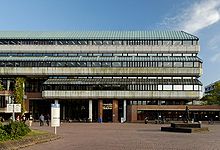
Düsseldorf University and State Library
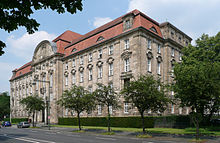
Düsseldorf Higher Regional Court on Cecilienallee
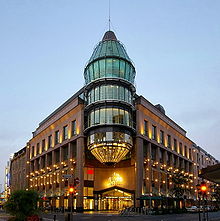
Schadow-Arkaden
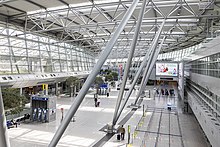
Departure level within Düsseldorf Airport
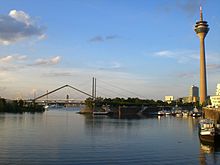
Düsseldorf port
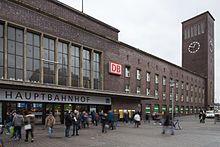
Düsseldorf main station

Train station Düsseldorf Airport
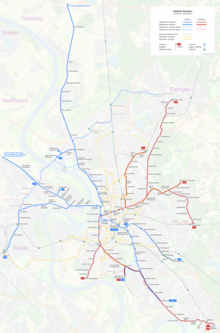
Düsseldorf tram and light rail network

Pedestrian traffic light with yellow phase
_2010-08-13_212.jpg)
Mannesmann high-rise, home of the NRW Ministry of Economic Affairs since 2013
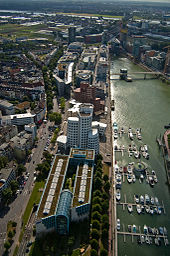
WDR (front), Neuer Zollhof (Gehry buildings) and part of the Media Harbor
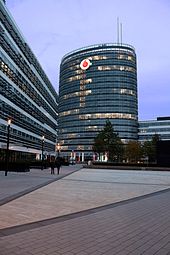
Vodafone Campus
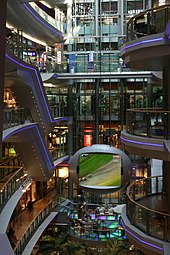
Futuristic shopping center - the Sevens Center in 2005, reopened at the end of 2011 after reconstruction.
See also
- Rivalry between Düsseldorf and Cologne
Questions and Answers
Q: What is the character ü in the title referring to?
A: The character ü in the title refers to the German letter ü in the name of the city Düsseldorf.
Q: Can the name of the city be written as Duesseldorf?
A: Yes, if the ü character is unavailable or not wanted, the name of the city Düsseldorf can be written as Duesseldorf.
Q: Where is Düsseldorf located?
A: Düsseldorf is located on the east bank of the river Rhine.
Q: What is Düsseldorf's status in Germany?
A: Düsseldorf is the capital of the state of North Rhine-Westphalia.
Q: How many people live in Düsseldorf?
A: Düsseldorf has about 600,000 inhabitants, and about 1.3 million people live in the city and surrounding areas.
Q: What are some notable features of Düsseldorf?
A: Some features of Düsseldorf include one international airport, a university, and the headquarters of many international companies.
Q: What are some alternative names for Düsseldorf?
A: Some alternative names for Düsseldorf include Düsseldörp in Low Franconian and Ripuarian, Dusseldorp in archaic Dutch, and Dusseldorpium in Latin.
Search within the encyclopedia
.svg.png)
